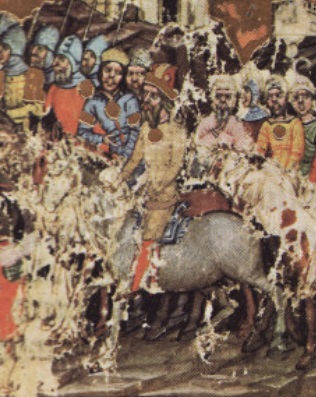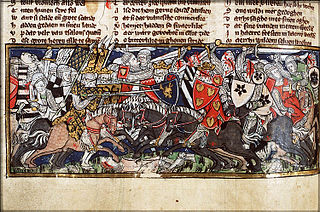Related Research Articles

The Huns were a nomadic people who lived in Central Asia, the Caucasus, and Eastern Europe between the 4th and 6th centuries AD. According to European tradition, they were first reported living east of the Volga River, in an area that was part of Scythia at the time. By 370 AD, the Huns had arrived on the Volga, causing the westwards movement of Goths and Alans. By 430, they had established a vast, but short-lived, empire on the Danubian frontier of the Roman empire in Europe. Either under Hunnic hegemony, or fleeing from it, several central and eastern European peoples established kingdoms in the region, including not only Goths and Alans, but also Vandals, Gepids, Heruli, Suebians and Rugians.

Bleda was a Hunnic ruler, the brother of Attila the Hun.

Onegesius was a powerful Hunnic logades (minister) who supposedly held power second only to Attila the Hun. According to Priscus he "seated on a chair to the right of the king" i.e. Attila.

The Hunnic language, or Hunnish, was the language spoken by Huns in the Hunnic Empire, a heterogeneous, multi-ethnic tribal confederation which invaded Eastern and Central Europe, and ruled most of Pannonian Eastern Europe, during the 4th and 5th centuries CE. A variety of languages were spoken within the Hun Empire. A contemporary report by Priscus has that Hunnish was spoken alongside Gothic and the languages of other tribes subjugated by the Huns.
Mundzuk was a Hunnic chieftain, brother of the Hunnic rulers Octar and Rugila, and father of Bleda and Attila by an unknown consort. Jordanes in Getica recounts "For this Attila was the son of Mundzucus, whose brothers were Octar and Ruas, who were supposed to have been kings before Attila, although not altogether of the same [territories] as he".
Attila is a popular masculine name in Central and Eastern Europe, Southeastern Europe and Western Asia. Primarily in Hungary, Turkey, Bulgaria and Chuvashia. Attila is the most used version in Hungary, however another version of Attila is Atilla and Etele, the female equivalent of which is Etelka. Attila is used as Atilla in Turkish.

The Akatziri, Akatzirs or Acatiri were a tribe that lived north of the Black Sea, though the Crimean city of Cherson seemed to be under their control in the sixth century. Jordanes called them a mighty people, not agriculturalists but cattle-breeders and hunters. Their ethnicity is undetermined: the 5th-century historian Priscus describes them as ethnic Scythians, but they are also referred to as Huns. Their name has also been connected to the Agathyrsi. However, according to E. A. Thompson, any conjectured connection between the Agathyrsi and the Akatziri should be rejected outright.
Ernak was the last known ruler of the Huns, and the third son of Attila. After Attila's death in 453 AD, his Empire crumbled and its remains were ruled by his three sons, Ellac, Dengizich and Ernak. He succeeded his older brother Ellac in 454 AD, and probably ruled simultaneously over Huns in dual kingship with his brother Dengizich, but in separate divisions in separate lands.
Rugila or Ruga, was a ruler who was a major factor in the Huns' early victories over the Roman Empire. He served as an important forerunner with his brother Octar, with whom he initially ruled in dual kingship, possibly a geographical division where Rugila ruled over Eastern Huns while Octar over Western Huns, during the 5th century AD.
Dengizich, was a Hunnic ruler and son of Attila. After Attila's death in 453 AD, his empire crumbled and its remains were ruled by his three sons, Ellac, Dengizich and Ernak. He succeeded his older brother Ellac in 454 AD, and probably ruled simultaneously over the Huns in dual kingship with his brother Ernak, but separate divisions in separate lands.
Charaton was one of the first kings of the Huns.

Uldin, also spelled Huldin is the first ruler of the Huns whose historicity is undisputed.

Ellac was the oldest son of Attila (434–453) and Kreka. After Attila's death in 453 AD, his empire crumbled, and its remains were ruled by his three sons, Ellac, Dengizich and Ernak. He ruled briefly and died at the Battle of Nedao in 454 AD. Ellac was succeeded by his brothers, Dengizich and Ernak.
Octar or Ouptaros was a Hunnic ruler. He ruled in dual kingship with his brother Rugila, possibly with a geographical division, ruling the Western Huns while his brother ruled the Eastern Huns.
By the name Edeko are considered three contemporaneous historical figures, whom many scholars identify as one:

Kreka or Hereka was the wife of Attila. She was described by Eastern Roman diplomat Priscus in his account of his stay at Attila's court in 448 or 449 AD. She and Attila had three sons: Ellac, Dengizich, and Ernak, who split among themselves what remained of Attila's empire after his death in 453.

Balamber was ostensibly a chieftain of the Huns, mentioned by Jordanes in his Getica. Jordanes simply called him "king of the Huns" and writes the story of Balamber crushing the tribes of the Ostrogoths in the 370s; somewhere between 370 and more probably 376 AD.

Laudaricus was a prominent Hunnic chieftain and general active in the first half of the 5th century.
Basich or Basikh was a Hun military commander who co-led an invasion of Persia in 395 AD together with Kursich.
Kursich was a Hun general and royal family member. He led a Hunnish army in the Hunnic invasion of Persia in 395 AD.
References
- ↑ Maenchen-Helfen, Otto. "Eskam" . Retrieved 7 December 2022.
- ↑ Archivum Eurasiae Medii Aeivi Volumes 2-4. Otto Harrassowitz. 1983. p. 90. Retrieved 7 December 2022.
- ↑ Pritsak, Omeljan (1982). "The Hunnic Language of the Attila Clan" (PDF). Harvard Ukrainian Studies. IV (4). Cambridge, Massachusetts: Harvard Ukrainian Research Institute: 442–443. ISSN 0363-5570. Archived from the original (PDF) on 2016-12-13. Retrieved 2015-11-23.
- ↑ Ripinsky-Naxon, Michael (1993). The Nature of Shamanism Substance and Function of a Religious Metaphor. State University of New York Press. p. 163. ISBN 9780791413869.
- ↑ Wolfram, Herwig (2005). Dunlap, Thomas (ed.). The Roman Empire and Its Germanic Peoples. University of California Press. pp. 131, 351. ISBN 9780520244900.
- 1 2 3 Hughes, Ian (2019). Attila the Hun Arch-Enemy of Rome. Pen & Sword Books. ISBN 9781473890329 . Retrieved 7 December 2022.
- ↑ Herbert, William (1838). Attila King of the Huns. H.G. Bohn. p. 382. Retrieved 7 December 2022.